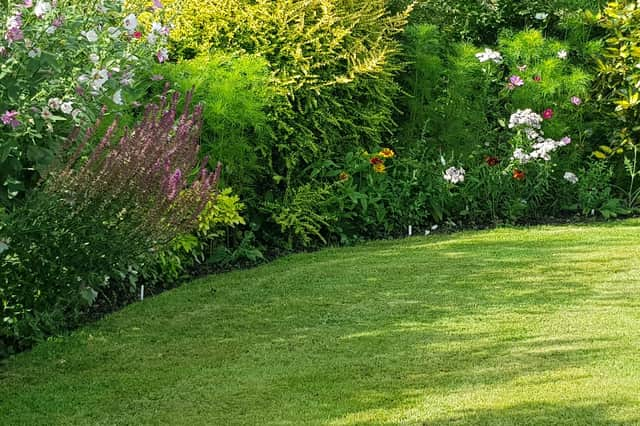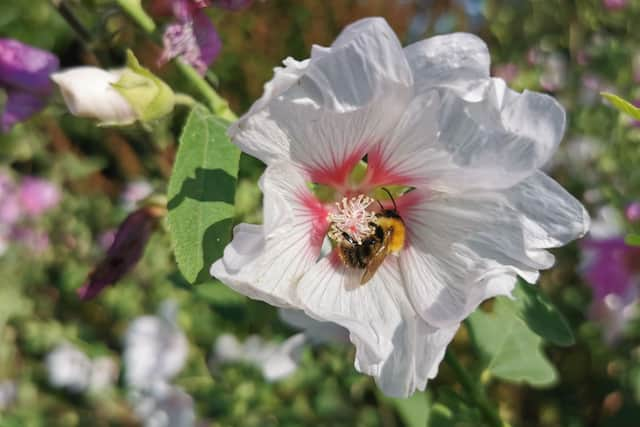Hints that autumn’s just round the corner


Foremost in this is the simple dead-heading process of removing spent flowers down to the nearest leaf joint. Annuals and many perennials respond by producing new bloom buds in their natural drive toward seed production. Continuity of colour comes when this is a daily occurrence. Dead heading on a weekly basis, leads to a build-up of spent blooms and when they’re removed there’s a disappointing void. In the case of annual bedding, basket and container plants this can be short-lived as existing lateral stems rise to the fore and shine. However, roses, especially after a period of wet weather wipes out the existing display, can take a few weeks to recover equilibrium. Little and often is best for them.
Watering and feeding also help keep the summer flowering extravaganza on the road. Anything planted in containers, from ornamentals to dwarf fruit trees and bushes, will exhaust both elements rapidly. Don’t ease off on either of these essentials simply because there’s a hint of autumn in the morning air.
Advertisement
Hide AdAdvertisement
Hide AdWalk along any of the flower borders in this garden, and areas of bare soil are difficult to find. There is an abundance of lush summer growth which by September can become overpowering. Some plants can be rather aggressive and would take over given a chance, so the caring gardener must undertake some decisive pruning to protect less invasive varieties in bloom.


We’ve recently reduced some nepeta ‘Six Hills Giant’ (catmint) that had ceased flowering, also a few herbaceous geraniums, including ‘Rozanne’. Both will respond with new growth and possibly repeat flowering. Meanwhile two less vigorous salvias they’d been smothering, ‘Hot Lips’ and ‘Nachtvlinder’, have been given space to continue flowering. Several of the early herbaceous perennials are now carrying ungainly stems so it’s time to remove them and see how rudbeckias, cosmos, asters, sedum and autumn crocus thrive in the extra space they’ve gained .
Naturally, none of the border debris resulting from these pruning sessions is wasted. It goes straight into the composting facility. Brown stems, green leaves, annual weeds not in seed, they`re all good for recycling.
PRUNING CAN BE THE KINDEST CUT OF ALL
Whether you’re cutting back excess foliage, removing spent blooms, reducing the height of a plant or snipping away at dead or diseased wood, it’s all recognised as essential pruning. And that is a year-round gardening activity.
Advertisement
Hide AdAdvertisement
Hide AdApproaching autumn sees the removal of dead herbaceous stems that would otherwise litter the garden over winter, exceptions being those with ornamental seed capsules or attractive spent flower heads that are enhanced by frost or snow or wanted for indoor arrangements. Teasel (dispacus), poppy (papaver) and yarrow (achillea) are personal favourites. With necessary spent growth removed, we can then weed and point over the soil before applying an organic mulch.
December onward offers us a skeletal view of deciduous woody perennials, shrubs, currant fruit bushes, gooseberries, apples and the like, so it’s the ideal time to prune some but not all. For example, winter pruning of plum trees creates wounds that allow the debilitating silver leaf disease entry. Safest time to act is May/June, in the absence of frost.
Tempting though it is to take secateurs to all shrubs in late autumn, “Just to tidy them up” as one gardening acquaintance once put it, and wondered why they never bloomed, you could be doing more harm than good. It would minimise the display of winter flowering types, viburnum, jasmine etc. and spring icons such as forsythia are currently covered in ripened stems that will burst into a golden May display. Don’t remove those until they’ve done their job.
Lavatera ‘Barnsley Baby’ is in full glorious bloom right now with soft, vigorous growth, that will suffer in strong autumn winds and winter frost. It’s fine at present but in late September I’ll reduce the height. Pruning at the right time, can be the kindest cut of all!